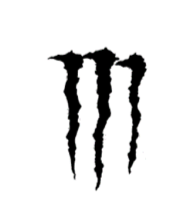“It would be a severe blow to the NBA team’s iconic brand if the Raptors were forced to stop using its new 2014 logo. But the length of the dispute and the number of requests for time extensions suggests that perhaps the two parties have been negotiating a settlement.”
 Torontonians may have accepted the loss of Kawhi Leonard, but another Raptors asset is still at risk: their newest logo.
Torontonians may have accepted the loss of Kawhi Leonard, but another Raptors asset is still at risk: their newest logo.
As detailed here, the Raptors are tipping off against energy drink company, Monster, who allege the Raptors’ logo—featuring a clawed-up basketball—is confusingly similar to their own claw-mark logo. Since first filing their United States trademark opposition suit in 2015, Monster has continued their court battle against the Raptors for the last four years with no known resolution to date.
Monster has a whopping 176 trademarks active in Canada at this time. Their most recognizable and widely used mark contains three jagged vertical gashes, resembling those from a claw, in the shape of the letter M. Since 2002, Monster has used the claw-like logo on everything from their beverage products, to event sponsorships, to clothing.
The “M” trademark registered by Monster Energy Company (top) and the disputed Raptors logo (bottom).
The Raptors, on the other hand, have only been using their clawed-up basketball logo since 2014, when they underwent a brand redesign, and do not own a federal trademark registration for the rebranded mark in Canada. This is because Monster clawed back against the Raptors almost immediately after Maple Leaf Sports and Entertainment (MLSE), who owns the NBA team, attempted to register the new logo in 2014. In the United States, however, two of the Raptors trademark registrations were approved before Monster took notice and any actions. Since the opposition period has ended, Monster is now requesting post-grant cancellation of those Raptor trademarks.
Evolution of the Raptors Claw
In the U.S. cancellation proceedings, MLSE relied on its original Raptors brand to dispute Monster’s allegations. In what is known as a “Morehouse defense,” or the “prior registration defense,” MLSE claimed the current Raptors logo is “the same or substantially the same” as the three-clawed basketball representing a dinosaur foot. That logo, shown below, has been in use and protected since 1994 when the Raptors were first introduced to the NBA amidst the Jurassic Park fanfare of the early ‘90s. However, the Raptors’ design was changed from independent claws beside a basketball to the 2014 design of claws within a basketball. The two trademarks shown here:
The Raptors’ alternate logo released and protected in 1994 (left) and the Raptors’ new logo created during 2014 rebrand (right).
In May 2019, Monster asked the Trademark Trial and Appeal Board (TTAB) to grant a summary judgment, which would immediately cancel the two trademark registrations. Monster argued the 1994 logo should not be an issue at trial because the Morehouse defense requires two design marks to be “substantially identical”, not merely similar. Monster claimed the two sets of Raptors’ claws are too different. Monster also alleged that the Raptors in fact intended to create new marks in an effort to revive the aging Raptors brand. Furthermore, one of the new marks added the words “TORONTO RAPTORS”, which is not found in the old mark — which Monster has cited as a clear disconnect between the old and new versions.
Ultimately, this argument may be found weak. U.S. courts have been intolerant of even modest changes to trademarks. The Raptors did not contest Monster’s request, and in June, the TTAB struck the Morehouse defense from the proceedings. At trial, the Raptors will not be able to simply argue that they have prior rights through their 1994 logo. Instead, they will need to persuade TTAB that their new logo is not confusingly similar with the Monster logo.
Fluid Trademarks
In this dispute, we have a popular logo from an NBA franchise that is easily attributed to the Raptors on one hand, and on the other we have an equally recognizable logo that is associated with Monster Energy. In order to block the Raptors’ registration of their new trademark, Monster must prove that consumers are likely to be confused by the similarity of the Monster logo with the new Raptors logo. On the other hand, the Raptors may possibly be able to successfully argue that if their older 1994 registered trademark co-existed with Monsters mark, why should their new mark be confused? Essentially, both trademarks may be limited in their distinctiveness because of earlier coexistence.
Indeed, trademark law in the United States and Canada does not require maintenance of the exact design of a mark to avoid relinquishment; it simply requires continuing commercial identity of the mark to remain recognizable in order to prevent confusion among unaware consumers. Many brands today make modifications to their logos without registering the changes—this is known as a “fluid trademark”—however, as shown by this lawsuit, not filing is not necessarily recommended unless the change is very minor, and even then issues can arise.
It appears that in order for the Raptors to succeed in this case they first must demonstrate that they have continuously used their old 1994 design since it’s registration. If discontinued use is found, the Raptors having essentially abandoned their original mark, Monster would be the senior user even if initially Monster was the junior user. Monster would certainly request that the Raptors original registration be expunged from the Trademark Register for not being in use. However, assuming the Raptors can demonstrate continued use of their old mark sufficient to allow them to claim either early rights in a craggy claw design, or a family of craggy claw marks, they may likely be successful in ensuring their craggy claw rights are not clawed back.
Bottom line, if the old Raptors claws remained in use and Monsters claws co-existed without confusion, it may be found that so too can the newer Raptor claws. We suspect this case may settle, with Monster securing promises from the Raptors to limit future use that takes the design any closer to Monster’s use.
Guiding Principles
Fluid trademarks are a relatively recent phenomenon, so as compared to other trademark issues there is little case law to date. In the United States, with the Morehouse defense, there is some well-developed law if not for “fluidity” per se at least covering careful changes to a mark. In Canada, a few cases reveal that courts require variants to retain the “distinctive” or “dominant” features of the registered mark. Madam Justice Reed we think got it summarized correctly even if she was ultimately overturned. The guiding principles should be:
- Are the essential features retained?
- Does the deviation touch on one of the dominant elements?
- Would the change deceive?
- Are only insignificant features added to it?
Note that number three is not so relevant for general assessments.
Nonetheless, it is safer to register each new trademark variation in order to avoid disputes over a fluid mark. It would be a severe blow to the NBA team’s iconic brand if the Raptors were forced to stop using its new 2014 logo. But the length of the dispute and the number of requests for time extensions suggests that perhaps the two parties have been negotiating a settlement. While Monster continues their attempts to bring down the Raptors’ iconic branding in the courts, they cannot take away the 2019 NBA Championship win on the court!
Source:
https://unsplash.com/photos/OywyPkrDEvg
Photo by Ryan on Unsplash

![[IPWatchdog Logo]](https://ipwatchdog.com/wp-content/themes/IPWatchdog%20-%202023/assets/images/temp/logo-small@2x.png)






![[Advertisement]](https://ipwatchdog.com/wp-content/uploads/2024/04/Patent-Litigation-Masters-2024-sidebar-early-bird-ends-Apr-21-last-chance-700x500-1.jpg)

![[Advertisement]](https://ipwatchdog.com/wp-content/uploads/2021/12/WEBINAR-336-x-280-px.png)
![[Advertisement]](https://ipwatchdog.com/wp-content/uploads/2021/12/2021-Patent-Practice-on-Demand-recorded-Feb-2021-336-x-280.jpg)
![[Advertisement]](https://ipwatchdog.com/wp-content/uploads/2021/12/Ad-4-The-Invent-Patent-System™.png)







Join the Discussion
No comments yet.